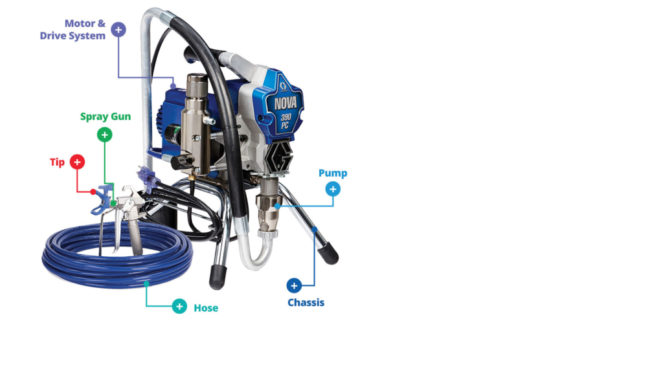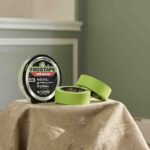A paint sprayer is a professional painter’s best friend on the job site, allowing them to do high-quality work quickly. And when a sprayer breaks down, that same painter can find their productivity severely diminished. No one wants to deal with equipment issues in the middle of a project.
“When contractors trust their business to equipment that is going to drive their productivity, it’s important that they buy a high-quality product that their teams can rely on, day in and day out,” says Dan Johnson, Global Total Markets Manager at Graco. “I was just at a job site yesterday where a painter was using an Ultimate 695 – a 30-year old model that was still getting it done.”
Knowing your equipment inside and out can be the key to getting the most out of it.
In this article, Johnson explains the major components of an airless paint sprayer, explaining both how each part works and how to choose the right sprayer for your team.
1. Motor and drive system
The motor and drive system is responsible for powering and moving the pump. Electric airless pump motors come in AC, DC, Brushless DC, and Universal technologies. Brushless DC motors are the most forgiving of power fluctuations on the jobsite and deliver more torque and maintenance-free performance. The maximum PSI and GPM increases with the motor size.
Though electric motor and drive systems – which operate quietly and with low emissions – are the most popular option, gas-powered systems – as well as some newly introduced battery-powered systems – can be useful for jobs where crews will not have access to electricity, require portability, or need sprayers to maintain a very high output.
2. Pump
Johnson calls the airless pump “the heart of the system,” as it takes in and pressurizes the coating to deliver the pressure necessary for atomization. Piston pumps, like Graco’s Endurance Chromex piston pump, are very popular because they deliver extended durability on the job site and can handle thicker materials. Graco’s piston pumps also come with ProConnect, so that when service is eventually needed, end users can easily swap out the pump in minutes on the job site to maximize uptime, with no tools required.
3. Pressure control
For airless systems, the pressure control is a critical component that helps painters adjust and dial into pressure. Better pressure control means the system can run at a consistent pressure without fluctuations, leading to smoother and higher-quality finish. For example, Graco’s Smart Control system constantly monitors performance and automatically adjusts the pressure and flow based on the spray tip that’s installed.
4. Hose
The fluid hose moves the paint from the pump to the spray gun. Most hoses run roughly 50 to 300 feet long. Choosing a longer hose provides extended reach on job sites, but they take much more material to fill before spraying and may require a larger pumping system.
5. Spray gun
The airless spray gun may be the most familiar component to painters, as it’s the component they hold all day long. The gun acts as an on/off valve for the coating. Because painters hold the spray gun all day, Johnson says it’s important to find one that is lightweight and comfortable: “If a painter’s fatigued, they’re going to spray less. So Graco offers the Contractor PC: the lightest, most comfortable airless spray gun platform on the market.”
6. Spray tip
Spray tips have the most impact on the finish. Tip size can range from .006 inch – commonly used for stains – all the way to .035 inch, which is used for smooth elastomerics. In general, when applying light viscosity coatings like stains and lacquers, use spray tips with smaller orifice sizes, while heavier viscosity coatings call for spray tips with larger orifices.
For painters who want to stay productive, it’s important to keep tips in good condition and regularly switch out worn tips. Worn tips use more paint, produce uneven and inconsistent coverage, require more passes, reduce production, and result in a poor-quality finish.
Manufacturers continue to innovate on these components, as well, so it’s important to stay up-to-date on the latest productivity-enhancing releases.
For example, Graco recently launched a line of low-pressure spray tips that are being implemented on all their paint sprayers starting this year.
“Low-pressure spray tips are a breakthrough in airless sprayer technology,” Johnson says. “They allow customers to extend their tip life, because if you spray at lower pressure, your tip and sprayer last longer. In addition, they reduce the amount of overspray or material in the air, so contractors get more paint on the substrate with less prep. Not a lot of contractors are aware of this technology, but it’s an important development all painters should know about.”
Another recent innovation is the Ultimate QuickShot, which was unveiled earlier this year and is available through Sherwin-Williams stores. Billed as the fastest way to complete all small jobs, the Ultimate QuickShot is a portable airless sprayer that can be holstered on your hip and is outfitted with a six-foot hose and the first-ever electric-powered spray gun. The tool was designed to help contractors efficiently handle smaller jobs, like spraying doorframes, accent walls or completing touchups.
Beyond individual components, Johnson also emphasizes that it’s important to pay attention to the sprayer brand. Users looking for high-quality performance should strongly consider well-known brands, and these brands are also the most likely to offer strong warranties and build quality. For example, Johnson notes that Graco offers a lifetime warranty on electric motor and drive systems, as well as in-field service and repairs on sprayer components.
The time and money painters will save by purchasing a high-quality sprayer and eliminating downtime will maximize their profit, according to Johnson.
“It is important for customers to know the construction and how the system operates,” Johnson says. “But what’s even more important for a customer to know is that they’re buying from a reputable brand. Painters need to know it’s a quality product that’s going to last them a long time. And they will get the support that they need from Sherwin-Williams and Graco.”
This story was published in the Summer 2023 issue of Pintor Pro magazine. ©2023 Randall Reilly. Read more stories about paint products and application techniques in the Pintor Pro magazine archive.




